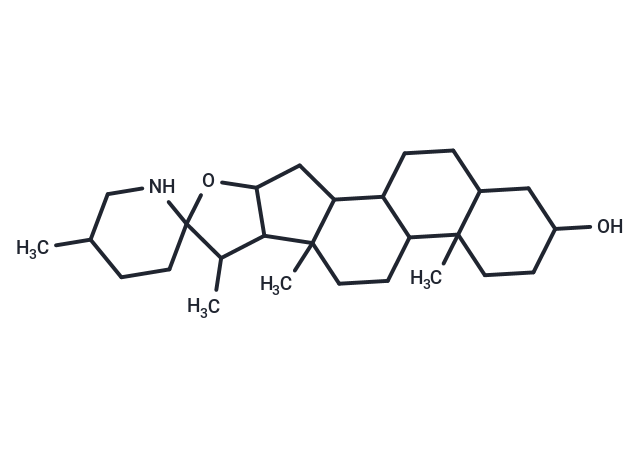Shopping Cart
- Remove All
 Your shopping cart is currently empty
Your shopping cart is currently empty

Tomatidine serves as an anti-inflammatory agent by inhibiting NF-κB and JNK signaling pathways. Additionally, it induces autophagy in both mammalian cells and C. elegans.

| Pack Size | Price | Availability | Quantity |
|---|---|---|---|
| 5 mg | $42 | In Stock | |
| 10 mg | $58 | In Stock | |
| 25 mg | $115 | In Stock |
| Description | Tomatidine serves as an anti-inflammatory agent by inhibiting NF-κB and JNK signaling pathways. Additionally, it induces autophagy in both mammalian cells and C. elegans. |
| In vitro | Staphylococcus aureus (S. aureus) is responsible for difficult-to-treat and relapsing infections and constitutes one of the most problematic pathogens due to its multiple resistances to clinically available antibiotics. Additionally, the ability of S. aureus to develop small-colony variants is associated with a reduced susceptibility to aminoglycoside antibiotics and in vivo persistence. METHODS AND RESULTS: We have recently demonstrated that Tomatidine, a steroid alkaloid isolated from tomato plants, possesses anti-virulence activity against normal strains of S. aureus as well as the ability to potentiate the effect of aminoglycoside antibiotics. In addition, Tomatidine has shown antibiotic activity against small-colony variants of S. aureus. CONCLUSIONS: We herein report the first study of the structure-activity relationship of Tomatidine against S. aureus. |
| Molecular Weight | 415.65 |
| Formula | C27H45NO2 |
| Cas No. | 77-59-8 |
| Smiles | CC1C2C(CC3C4CCC5CC(O)CCC5(C)C4CCC23C)OC11CCC(C)CN1 |
| Relative Density. | 1.0048 g/cm3 (Estimated) |
| Storage | Powder: -20°C for 3 years | In solvent: -80°C for 1 year | Shipping with blue ice. | |||||||||||||||
| Solubility Information | 0.1 M HCL: < 1 mg/mL (insoluble) DMSO: 2.86 mg/mL (6.88 mM), Sonication is recommended. | |||||||||||||||
Solution Preparation Table | ||||||||||||||||
DMSO
| ||||||||||||||||

Copyright © 2015-2025 TargetMol Chemicals Inc. All Rights Reserved.